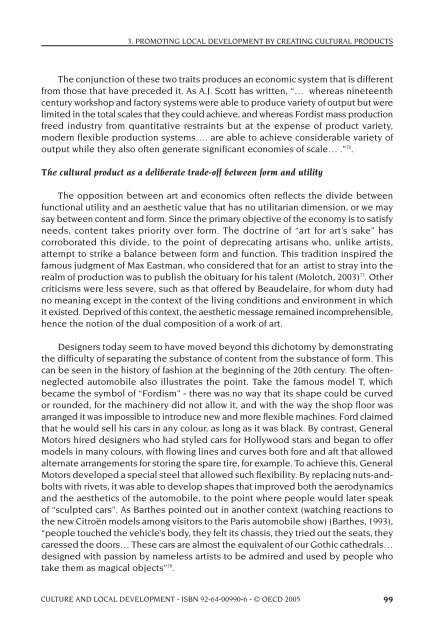OECD Culture and Local Development.pdf - PACA
OECD Culture and Local Development.pdf - PACA
OECD Culture and Local Development.pdf - PACA
You also want an ePaper? Increase the reach of your titles
YUMPU automatically turns print PDFs into web optimized ePapers that Google loves.
3. PROMOTING LOCAL DEVELOPMENT BY CREATING CULTURAL PRODUCTS<br />
The conjunction of these two traits produces an economic system that is different<br />
from those that have preceded it. As A.J. Scott has written, “… whereas nineteenth<br />
century workshop <strong>and</strong> factory systems were able to produce variety of output but were<br />
limited in the total scales that they could achieve, <strong>and</strong> whereas Fordist mass production<br />
freed industry from quantitative restraints but at the expense of product variety,<br />
modern flexible production systems…. are able to achieve considerable variety of<br />
output while they also often generate significant economies of scale… .” 76 .<br />
The cultural product as a deliberate trade-off between form <strong>and</strong> utility<br />
The opposition between art <strong>and</strong> economics often reflects the divide between<br />
functional utility <strong>and</strong> an aesthetic value that has no utilitarian dimension, or we may<br />
say between content <strong>and</strong> form. Since the primary objective of the economy is to satisfy<br />
needs, content takes priority over form. The doctrine of “art for art’s sake” has<br />
corroborated this divide, to the point of deprecating artisans who, unlike artists,<br />
attempt to strike a balance between form <strong>and</strong> function. This tradition inspired the<br />
famous judgment of Max Eastman, who considered that for an artist to stray into the<br />
realm of production was to publish the obituary for his talent (Molotch, 2003) 77 . Other<br />
criticisms were less severe, such as that offered by Beaudelaire, for whom duty had<br />
no meaning except in the context of the living conditions <strong>and</strong> environment in which<br />
it existed. Deprived of this context, the aesthetic message remained incomprehensible,<br />
hence the notion of the dual composition of a work of art.<br />
Designers today seem to have moved beyond this dichotomy by demonstrating<br />
the difficulty of separating the substance of content from the substance of form. This<br />
can be seen in the history of fashion at the beginning of the 20th century. The oftenneglected<br />
automobile also illustrates the point. Take the famous model T, which<br />
became the symbol of “Fordism” - there was no way that its shape could be curved<br />
or rounded, for the machinery did not allow it, <strong>and</strong> with the way the shop floor was<br />
arranged it was impossible to introduce new <strong>and</strong> more flexible machines. Ford claimed<br />
that he would sell his cars in any colour, as long as it was black. By contrast, General<br />
Motors hired designers who had styled cars for Hollywood stars <strong>and</strong> began to offer<br />
models in many colours, with flowing lines <strong>and</strong> curves both fore <strong>and</strong> aft that allowed<br />
alternate arrangements for storing the spare tire, for example. To achieve this, General<br />
Motors developed a special steel that allowed such flexibility. By replacing nuts-<strong>and</strong>bolts<br />
with rivets, it was able to develop shapes that improved both the aerodynamics<br />
<strong>and</strong> the aesthetics of the automobile, to the point where people would later speak<br />
of “sculpted cars”. As Barthes pointed out in another context (watching reactions to<br />
the new Citroën models among visitors to the Paris automobile show) (Barthes, 1993),<br />
“people touched the vehicle’s body, they felt its chassis, they tried out the seats, they<br />
caressed the doors… These cars are almost the equivalent of our Gothic cathedrals…<br />
designed with passion by nameless artists to be admired <strong>and</strong> used by people who<br />
take them as magical objects” 78 .<br />
CULTURE AND LOCAL DEVELOPMENT - ISBN 92-64-00990-6 - © <strong>OECD</strong> 2005 99














